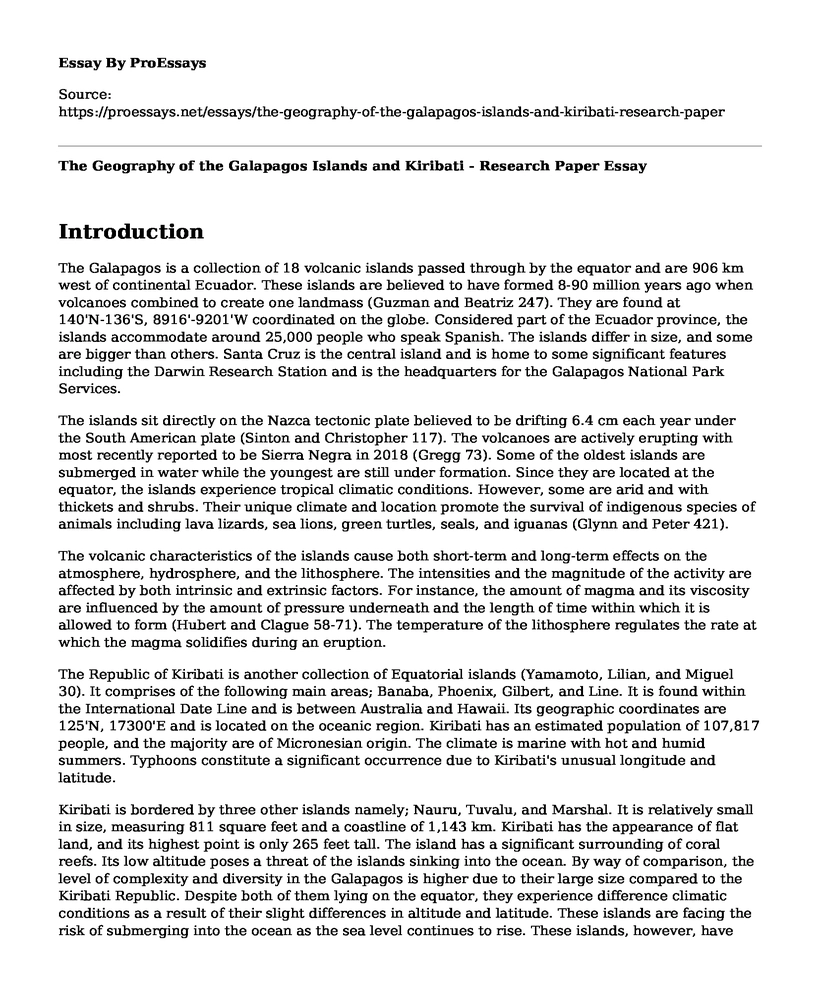Introduction
The Galapagos is a collection of 18 volcanic islands passed through by the equator and are 906 km west of continental Ecuador. These islands are believed to have formed 8-90 million years ago when volcanoes combined to create one landmass (Guzman and Beatriz 247). They are found at 140'N-136'S, 8916'-9201'W coordinated on the globe. Considered part of the Ecuador province, the islands accommodate around 25,000 people who speak Spanish. The islands differ in size, and some are bigger than others. Santa Cruz is the central island and is home to some significant features including the Darwin Research Station and is the headquarters for the Galapagos National Park Services.
The islands sit directly on the Nazca tectonic plate believed to be drifting 6.4 cm each year under the South American plate (Sinton and Christopher 117). The volcanoes are actively erupting with most recently reported to be Sierra Negra in 2018 (Gregg 73). Some of the oldest islands are submerged in water while the youngest are still under formation. Since they are located at the equator, the islands experience tropical climatic conditions. However, some are arid and with thickets and shrubs. Their unique climate and location promote the survival of indigenous species of animals including lava lizards, sea lions, green turtles, seals, and iguanas (Glynn and Peter 421).
The volcanic characteristics of the islands cause both short-term and long-term effects on the atmosphere, hydrosphere, and the lithosphere. The intensities and the magnitude of the activity are affected by both intrinsic and extrinsic factors. For instance, the amount of magma and its viscosity are influenced by the amount of pressure underneath and the length of time within which it is allowed to form (Hubert and Clague 58-71). The temperature of the lithosphere regulates the rate at which the magma solidifies during an eruption.
The Republic of Kiribati is another collection of Equatorial islands (Yamamoto, Lilian, and Miguel 30). It comprises of the following main areas; Banaba, Phoenix, Gilbert, and Line. It is found within the International Date Line and is between Australia and Hawaii. Its geographic coordinates are 125'N, 17300'E and is located on the oceanic region. Kiribati has an estimated population of 107,817 people, and the majority are of Micronesian origin. The climate is marine with hot and humid summers. Typhoons constitute a significant occurrence due to Kiribati's unusual longitude and latitude.
Kiribati is bordered by three other islands namely; Nauru, Tuvalu, and Marshal. It is relatively small in size, measuring 811 square feet and a coastline of 1,143 km. Kiribati has the appearance of flat land, and its highest point is only 265 feet tall. The island has a significant surrounding of coral reefs. Its low altitude poses a threat of the islands sinking into the ocean. By way of comparison, the level of complexity and diversity in the Galapagos is higher due to their large size compared to the Kiribati Republic. Despite both of them lying on the equator, they experience difference climatic conditions as a result of their slight differences in altitude and latitude. These islands are facing the risk of submerging into the ocean as the sea level continues to rise. These islands, however, have played a significant role by helping geographers in the study of the factors affecting the biosphere, lithosphere, hydrosphere, and the atmosphere of volcanic islands.
Works Cited
Glynn, Peter W., et al. "Coral reef recovery in the Galapagos Islands: the northernmost islands (Darwin and Wenman)." Coral Reefs 34.2 (2015): 421-436.
Gregg, P. M., et al. "Stress triggering of the 2005 eruption of Sierra Negra volcano, Galapagos." Geophysical Research Letters (2018): 73-79.
Guzman, Beatriz, et al. "Evolutionary history of the endangered shrub snapdragon (G alvezia leucantha) of the Galapagos Islands." Diversity and Distributions 23.3 (2017): 247-260.
Sawday, Jonathan. "They Shall No More Be Remembered by Their Name: Cartography, Anatomy, and the Renaissance Eponym." Journal of Medieval and Early Modern Studies 48.1 (2018): 11-40.
Sinton, Christopher W., et al. "Age Progressive Volcanism Opposite Nazca Plate Motion: Insights from Seamounts and Drowned Islands on the Northeastern Margin of the Galapagos Platform." Lithos (2018): 117-127.
Yamamoto, Lilian, and Miguel Esteban. The Atoll Island States and international law. Springer-Verlag Berlin An, (2016): 30-38.
Cite this page
The Geography of the Galapagos Islands and Kiribati - Research Paper. (2022, Dec 14). Retrieved from https://proessays.net/essays/the-geography-of-the-galapagos-islands-and-kiribati-research-paper
If you are the original author of this essay and no longer wish to have it published on the ProEssays website, please click below to request its removal:
- Effects of Physical Geography on Human Life
- Research Paper on Moscovium
- Paper Example on Mathematical Modeling Techniques
- Questions and Answers on Functions Paper Example
- Dynamic Earth - Essay Sample
- Is Color a Property of the Mind or an Inherent Characteristic of Nature - Essay Sample
- Paper Example on Rainfall: Critical to Global Hydrology and African Economies







